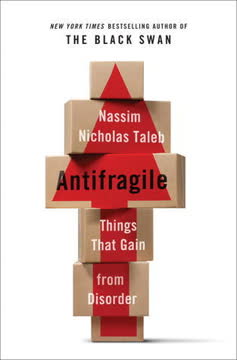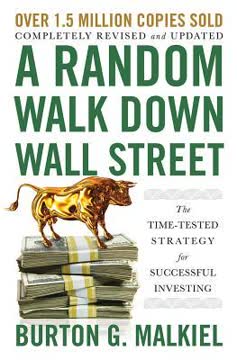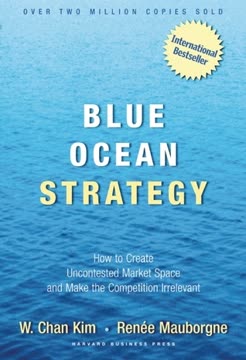Key Takeaways
1. Government Intervention, Not Free Market, Caused the Crisis.
It is not the market that has failed. It is intervention into the market that has failed.
Blame misplaced. The common narrative blames the free market, deregulation, and greed for the 2008 financial crisis. However, the crisis was a direct result of government intervention distorting market signals and incentives. The very people who created the problem are now proposing more of the same failed solutions.
Real culprits. Key government entities and policies distorted the housing market and financial system. These included government-sponsored enterprises (GSEs) like Fannie Mae and Freddie Mac, mandates for looser lending standards, and the Federal Reserve's monetary policy. Blaming "excessive risk-taking" or "greed" is like blaming gravity for a plane crash; it ignores the underlying systemic causes introduced by intervention.
Elephant in the room. The Federal Reserve, America's central bank, is rarely mentioned as a cause, often portrayed as a savior. Yet, its actions are central to understanding the crisis. The Fed's manipulation of money and interest rates is a fundamental intervention, not a free-market phenomenon, and its role must be acknowledged.
2. Fannie, Freddie, and Lending Mandates Fueled the Housing Bubble.
The special privileges granted to Fannie and Freddie have distorted the housing market by allowing them to attract capital they could not attract under pure market conditions.
GSE distortion. Fannie Mae and Freddie Mac, government-sponsored enterprises, enjoyed special privileges like implicit bailout guarantees. This allowed them to dominate the secondary mortgage market, buying loans from banks and fueling more lending than the free market would support. This artificial demand inflated home prices.
Mandated risk. Government agencies, driven by political goals like increasing homeownership, pressured lenders to loosen standards. The Community Reinvestment Act (CRA) and other initiatives pushed banks to make riskier loans, often on an "affirmative action" basis, despite warnings of higher default rates. This pervasive pressure eroded traditional lending prudence.
Speculative frenzy. Easier access to credit, including no-money-down and adjustable-rate mortgages, attracted speculators betting on ever-rising prices. When prices dipped slightly, foreclosures skyrocketed, revealing the fragility of the market built on artificially low standards and cheap credit. Ratings agencies, protected by regulation, also failed to accurately assess the risk.
3. The Fed's Cheap Credit Was the Primary Driver of the Boom.
The Fed’s policy of intervening in the economy to push interest rates lower than the market would have set them was the single greatest contributor to the crisis that continues to unfold before us.
Artificial rates. The Federal Reserve artificially lowered interest rates, notably to 1% for a year after the dot-com bust. This cheap credit flooded the economy, with more money created between 2000 and 2007 than in the rest of U.S. history. This new money disproportionately flowed into the housing market due to existing government incentives.
Misleading signals. Artificially low interest rates mislead investors and businesses. They signal that more savings are available for long-term projects than actually exist. This encourages malinvestment in unsustainable ventures, like excessive home construction, that would not be profitable under genuine market conditions.
Unsustainable boom. The resulting boom is a "sugar high," not genuine growth. Resources are misallocated, drawn away from projects that satisfy real consumer demand. As costs rise and the lack of real savings becomes apparent, the unsustainable projects fail, leading to the inevitable bust.
4. The "Too Big to Fail" Mentality Encourages Reckless Risk.
When monetary authorities repeatedly act to ward off economic downturns and continue to feed the markets with fresh liquidity, the belief in an eternal boom becomes more widespread each time, and economic activity becomes more intensive.
Moral hazard. The expectation that large financial institutions will be bailed out by taxpayers encourages reckless behavior. Firms take on excessive risk knowing that profits are privatized, but losses are socialized. This "Greenspan put" solidified the belief that the Fed would always intervene to prevent major failures.
Distorted incentives. This implicit guarantee allows favored firms to borrow more cheaply and take greater risks than they could in a truly free market. It shields them from the natural consequences of poor decisions, undermining market discipline. The result is a financial sector prone to instability and excess leverage.
Too big to be kept alive. While proponents argue these firms are too interconnected to fail, keeping them alive via bailouts is counterproductive. It drains resources from healthy firms and prolongs the misallocation of capital. Allowing failure, as with Lehman Brothers, allows assets to be reallocated to more competent hands.
5. Bailouts Prolong Crises and Reward Failure.
To combat the depression by a forced credit expansion is to attempt to cure the evil by the very means which brought it about.
Misdiagnosed problem. Bailouts are based on the false premise that the problem is a lack of credit or falling asset prices, rather than the underlying malinvestment caused by prior intervention. They attempt to prop up unsustainable positions instead of allowing necessary market corrections.
Counterproductive actions. The $700 billion bailout and subsequent interventions were erratic and ineffective. They failed to restore confidence or lending, while putting taxpayers on the hook for trillions. Rewarding mismanagement on a grand scale sends the wrong message and institutionalizes moral hazard across the economy.
War on reality. Attempts to prevent asset prices from falling are a "war on reality." Falling prices are the market's way of correcting prior distortions and revaluing assets rationally. Propping them up hinders the necessary adjustment and delays genuine recovery, just as similar policies did in the Great Depression and Japan's lost decade.
6. The Boom-Bust Cycle is Caused by Central Bank Manipulation.
The wavelike movement affecting the economic system, the recurrence of periods of boom which are followed by periods of depression, is the unavoidable outcome of the attempts, repeated again and again, to lower the gross market rate of interest by means of credit expansion.
Interest rate distortion. In a free market, interest rates coordinate saving and investment. Low rates signal increased saving, encouraging long-term projects. Central banks artificially lowering rates send false signals, leading businesses to invest in projects for which real savings are insufficient.
Malinvestment. This artificial stimulus creates a "cluster of errors" across the economy, particularly in capital-intensive industries. Resources are misdirected into unsustainable lines of production. The boom is characterized by apparent prosperity built on a foundation of malinvestment.
Inevitable bust. The boom cannot last because the necessary resources (real savings) to complete all projects do not exist. The bust is the painful but necessary process of liquidating these malinvestments and reallocating resources to sustainable uses. Government attempts to prevent this liquidation prolong the agony.
7. The Great Depression Was Prolonged by Government Intervention.
None of this is even slightly true.
Hoover's intervention. Contrary to popular myth, President Herbert Hoover was not a laissez-faire president. He intervened extensively with public works, tax increases, emergency loans, and wage/price supports. These actions took a normal downturn and exacerbated it into the Great Depression.
FDR's New Deal. Franklin D. Roosevelt's New Deal programs were largely extensions of Hoover's interventions, albeit on a larger scale. Policies aimed at propping up prices and wages, destroying crops, and cartelizing industries obstructed the market's ability to adjust. Scholars increasingly recognize the New Deal prolonged, rather than ended, the Depression.
WWII myth. The idea that World War II ended the Depression is a "stupefying and bizarre misunderstanding." Shifting millions to the military and rationing consumer goods doesn't create prosperity. The post-war boom occurred when the economy shifted back to producing consumer goods and the labor force returned.
8. Fiat Money is Inherently Unstable and Prone to Inflation.
The printing of the additional money is accompanied by no overall increase in the supply of bread, so when the shoemaker uses these new dollars to purchase bread, he necessarily draws resources away from other activities.
Government monopoly. Money originated spontaneously in the market, but governments monopolized its production, often debasing metal coins or issuing unbacked paper. Fiat money, unredeemable in a commodity, allows unlimited creation, enabling governments to fund spending without obvious taxation or borrowing.
Inflationary theft. Inflation (increase in money supply) devalues existing money. New money enters the economy at specific points, benefiting early recipients (often government and favored firms) who spend it before prices rise. Later recipients find their money's value diluted, a silent form of expropriation.
Discourages saving. Inflation discourages saving, as money loses value over time. This forces people into risky financial markets to preserve wealth. The system encourages debt and immediate consumption over thrift and long-term planning, contributing to economic fragility.
9. Government Spending ("Stimulus") Does Not Create Wealth.
What a country wants to make it richer is never consumption, but production.
Spending fallacy. The belief that consumer spending or government spending drives the economy is a fundamental error. Consumption is using things up; production creates them. You can only consume what has been produced, and your ability to consume comes from your own prior production.
Misallocated resources. Government "stimulus" spending, often on public works, diverts resources from the private sector. It taxes or borrows from wealth producers to fund arbitrary projects, hindering the market's ability to reallocate resources efficiently during a downturn. This is like borrowing money to remodel a house to solve a debt problem.
Saving fuels production. Saving is not a drag on the economy; it is essential. Savings provide the capital pool for investment in productive capacity. Increased production, fueled by saving and investment, leads to more goods, lower prices, and a higher standard of living.
10. Sound Money and Free Banking Offer a Stable Alternative.
To put it into the hands of an institution which is protected against competition, which can force us to accept the money, which is subject to incessant political pressure, such an authority will not ever again give us good money.
End the monopoly. The current system of central planning, monopoly privilege, and suppressed competition in money and banking is the opposite of a free market. It has proven unstable and prone to crises. A fundamental reform is needed, not just regulatory tinkering.
Commodity standard. A return to a commodity money like gold or silver, or allowing the market to choose, would impose discipline on government. Precious metals cannot be created infinitely, limiting inflationary spending and the ability to fund bailouts silently. Historically, commodity standards led to stable or falling prices and increased purchasing power.
Free banking. Abolishing the Fed and legal tender laws would allow for free competition in banking. Banks would be forced to be more prudent and maintain higher reserves, as they would face market discipline and the risk of runs if they over-inflated. This would eliminate the institutionalized moral hazard and reduce the likelihood of boom-bust cycles.
Last updated:
Review Summary
Meltdown by Thomas Woods presents an Austrian economics perspective on the 2008 financial crisis, blaming government intervention and Federal Reserve policies for creating artificial booms and busts. The book argues against Keynesian economics and advocates for free-market solutions. Readers generally found the book informative and accessible, though some criticized its tone as overly sarcastic. While praised for its clear explanations of complex economic concepts, some reviewers felt it oversimplified issues and presented a one-sided view. Overall, it's considered a good introduction to Austrian economics applied to recent economic events.
Similar Books










Download PDF
Download EPUB
.epub digital book format is ideal for reading ebooks on phones, tablets, and e-readers.





